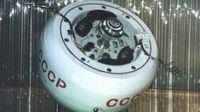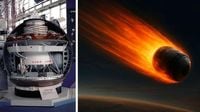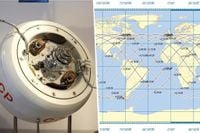This Saturday morning, May 10, 2025, the Soviet space probe Kosmos 482, launched in 1972 with the aim of exploring Venus, is expected to re-enter the Earth's atmosphere after more than half a century in orbit. This event has sparked both anticipation and concern among experts as they await the probe's descent, which could land nearly anywhere on the planet.
According to the European Space Agency (ESA), the probe is projected to re-enter around 8:37 AM Spanish peninsular time, although this prediction comes with a significant margin of error of plus or minus three hours and 20 minutes. The ESA's monitoring indicates that the most likely impact zone is vast, with the potential for the probe to land in the ocean, which covers approximately 75% of the Earth's surface.
Benjamín Bastida Virgili, a specialist in space debris monitoring at the ESA, explained the mechanics of re-entry: "Normally, an object re-entering is not like a meteorite. Objects slow down due to friction against the atmosphere at about 80 kilometers altitude, falling like a stone at approximately 300 meters per second." This means that while the probe is expected to descend rapidly, it may not disintegrate completely during the process.
The Kosmos 482 was launched as part of the Soviet Union's Venera program, intended to study Venus. However, a malfunction in its rocket prevented it from escaping Earth's gravitational pull, leaving it trapped in a low Earth orbit. Since then, it has become a piece of space debris, orbiting the Earth for over five decades.
Experts have noted that the probe's robust design—crafted to withstand the extreme conditions of Venus—raises the possibility that it could survive the re-entry and reach the Earth's surface intact. This has led to heightened interest in its descent, as the probe's diameter is about one meter, and it weighs less than 500 kilograms.
Marco Langbroek, an astronomer from Delft University in Germany, has indicated that the most probable date for re-entry is indeed May 10, 2025. He added that the trajectory of the probe is expected to be long and shallow, which could either lead to its disintegration or allow it to survive the atmospheric passage.
NASA previously alerted the public about the probe's decaying orbit, suggesting that it could enter the atmosphere anytime between May 7 and May 13, 2025. Such a wide window of uncertainty has kept scientists on their toes, and they are closely monitoring the probe's trajectory.
As the probe approaches re-entry, the question of where it will land remains largely unanswered. The NASA has indicated that the point of maximum approach to Earth is about 200 kilometers, with the potential impact area lying between 52 degrees north and south latitude. This means that the probe could theoretically strike any point on Earth outside the polar regions.
The situation is further complicated by various factors that can influence the re-entry process, such as solar activity, which can alter atmospheric conditions and affect the probe's descent. If the solar activity is high, the atmosphere expands, increasing friction on the probe and potentially causing it to re-enter earlier than expected.
While there are concerns about the potential impact of Kosmos 482, experts believe the risk of harm to people is extremely low. Kip Thorne, a Nobel Prize-winning physicist, has commented that the danger posed by this old Soviet probe is minimal compared to other risks, such as those associated with space weapons. He noted, "The chance of harming people is very small compared to other dangers we face. The risk of impacting a populated area is also very low, estimated at about one in 100 billion." This figure starkly illustrates the relative safety of the situation.
In terms of the potential impact, experts have suggested that if the probe survives the re-entry, it could strike the Earth's surface at speeds of around 240 km/h, which is comparable to the impact of a small meteorite. The kinetic energy released upon impact could be similar to that of 250 grams of dynamite, a significant but not catastrophic amount.
As the re-entry of Kosmos 482 approaches, the excitement among scientists is palpable. This event not only serves as a reminder of the long history of space exploration but also highlights the ongoing challenges posed by space debris. The ESA is capturing data during this event, which could provide valuable insights into atmospheric density at low orbits and help inform future space missions.
With the probe's descent imminent, the world watches closely. The legacy of Kosmos 482 is one of both ambition and caution, reminding us of the complexities and unpredictabilities of space exploration. As we await its final landing, experts continue to analyze the situation, ensuring that this piece of history will be documented and understood.







